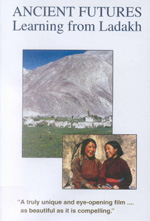
Brooklyn School for Music and Theatre
[Learning about The Himalayan Region through film]
| HOME |
| INTRODUCTION |
| LESSON 1 |
| LESSON 2 |
| LESSON 3 |
| LESSON 4 |
| LESSON 5 |
| LESSON 6 |
| LESSON 7 |
| LESSON 8 |
| FLASHCARDS |
| Geography Flashcards |

Film:Ancient Futures: Learning from Ladakh
Theme: Economic systems
Instructional objective: Students will be able to describe how a traditional agricultural society functioned in Ladakh
Motivation: Describe how people would behave in a perfect society? Do you believe such a perfect society could ever exist? Say why or why not
Central question: How did traditional agriculture shape the society of Ladakh?
Plot Summary:
Ancient Futures - Learning from Ladakh Ladakh, or "Little Tibet", is a wildly beautiful desert land high in the western Himalayas. It is a place of few resources and an extreme climate. Yet, for more than a thousand years, it has been home to a thriving culture. Traditions of frugality and co-operation, coupled with an intimate and location-specific knowledge of the environment, enabled the Ladakhis not only to survive, but to prosper. Then came "development". Now in Leh, the capital, one finds pollution and divisiveness, inflation and unemployment, intolerance and greed. Centuries of ecological balance and social harmony are under threat from modernisation. The breakdown of Ladakh's culture and enviroment forces us to re-examine what we really mean by "progress" -- not only in the "developing" parts of the world, but in the industrialized world as well. The story of Ladakh teaches us about the root causes of environmental, social and psychological problems. What happens when modern development encroaches upon an ancient culture high in the harsh Tibetan plateau of northern India? Not even Ladakhis--mostly Buddhists with deep spiritual ties to the earth--can resist the onslaught of an increasingly global economy. This case study, based on Helena Norberg-Hodge's book of the same title (pub, examines how development, with its attendant seductive images of glamour and gaddgets promising and end to hardship, destroys social and ecological bonds. Pollution, resource depletion, sprawl, breakdown of family and community, crime, growing economic disparity--all are crises in industrialized nations. While these problems are not the sole province of the West, Norberg-Hodge traces their appearance in Ladakh to Western notions of progress And because modernization has taken hold so rapidly here, the roots of these modern maladies, mostly obscured in the West, are easier to trace. "Development has systematically dismantled the local economy and self-reliance, and the first victim is the small farmer whose livelihood is completely undermined," Norberg-Hodge tells us. Ladakhis are buying heavily subsidized wheat trucked in from the plains of India because it's cheaper than grain grown minutes away in local villages. They are drifting away from a cooperative small-farm model, based on organic farming and renewable resources, toward dependence on chemical-intensive agriculture and imported goods and services. Once protected from food shortages and rationing by these close-knit communities, villagers are now at the mercy of market forces beyond their control and of roads that are impassable two-thirds of the year. Forced into competition for scarce, meaningless work that doesn't pay enough to meet basic needs, they've become alienated from their neighbors. Broken community ties have led to escalating crime and homelessness, virtually unheard of 20 years ago. "There has been progress," one Ladakhi says, "but people are not as happy as they once were."
Assignment:Write an essay explaining five features of traditional agriculture in Ladakh